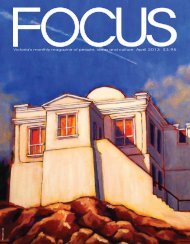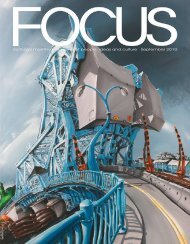Create successful ePaper yourself
Turn your PDF publications into a flip-book with our unique Google optimized e-Paper software.
“<br />
I DON’T UNDERSTAND THE LRT PROPOSAL. It doesn’t make sense<br />
to me... With the E&N, we could use the track that’s existing, and spend<br />
a few dollars to upgrade it. It’s mind boggling to me that that wouldn’t<br />
be the first thing we would do.” —Jim Hartshorne<br />
“Municipal operations is totally different from<br />
a provincial-scale, BC Transit way of doing<br />
things,” says Geoff Pearce, the chair of C4CR,<br />
and Langford’s former clerk-administrator.<br />
“We do what’s necessary, and if something<br />
doesn’t work, we fix it and then we go on.<br />
What we envisaged with commuter rail, starting<br />
small and growing, was quite different from<br />
what the Ministry of Transportation or BC<br />
Transit says, which is, ‘You’ve got to put in<br />
$60 million up front.’”<br />
That incremental approach has worked elsewhere.<br />
Cash-strapped and desperate for transit,<br />
several American cities have converted old<br />
freight railways over to commuter service:<br />
one example is New Jersey’s River Line, which<br />
uses diesel-powered vehicles that roll into<br />
downtown Camden like streetcars. Another<br />
example, even closer to our circumstances,<br />
comes from Texas: in 1994, Dallas’s transit<br />
authority bought 13 Budd cars from VIA (used<br />
ones cost as little as $100,000) and started<br />
running them on a bankrupt freight line for a<br />
commuter service called the Trinity Railway<br />
Express. Today, TRE carries 9,800 daily passengers<br />
on new trains, and has loaned its Budd<br />
cars to build up a new commuter line in nearby<br />
Denton County.<br />
Local commuter rail does face challenges<br />
beyond finding vehicles and money. C4CR’s<br />
$16-million scheme depended on rail coming<br />
across the Johnson Street Bridge—and so far,<br />
the City of Victoria has refused to investigate<br />
whether the new bridge could have rails embedded<br />
in its roadway (an idea pushed by this author),<br />
fearing increased costs and construction delays.<br />
“It’s going to take somebody to say, ‘Hey,<br />
this is important enough, we’ll put in $30,000<br />
to help Victoria look at that alternative. And<br />
let’s do it now rather than later,’” says Pearce,<br />
who wants to see the CRD create a regional<br />
funding formula for rail on the bridge.<br />
There’s also the question of which entity<br />
would run the commuter service. Southern<br />
Rail, which is currently contracted by the Island<br />
Corridor Foundation to operate the E&N,<br />
doesn’t have passenger insurance. Pearce says<br />
VIA would be the logical choice, if it brings<br />
back its Budd cars, and can be persuaded that<br />
connecting Langford and Victoria meets its<br />
intercity mandate. Alternatively, a whole new<br />
intermunicipal service could be created, or<br />
the rail system could be operated by the CRD<br />
or BC Transit.<br />
Unfortunately, the last two bodies currently<br />
seem entranced by LRT. The CRD board, the<br />
regional transit commission, and some local<br />
politicians have already endorsed BC Transit’s<br />
shiny $950-million plan—without much worrying<br />
about whether austerity-preaching federal and<br />
provincial governments will actually pay for it,<br />
or already-public opposition from the CRD<br />
Taxpayers’ Association and businesses afraid<br />
of losing two car lanes along Douglas Street.<br />
The LRT fantasy may also cost us opportunities<br />
that are staring us right in the face.<br />
Langford’s Westhills development has set aside<br />
$1 million for a commuter-rail station, and<br />
a park-and-ride system connecting it to buses.<br />
But there’s a time limit, and if rail doesn’t materialize<br />
by the end of 2013, Westhills will spend<br />
that money on other infrastructure.<br />
Jim Hartshorne, the prime project consultant<br />
for Westhills and president of the Westshore<br />
Developers’ Association, sat on BC Transit’s<br />
community-liasion panel for LRT. “And I can<br />
tell you: I don’t understand the LRT proposal.<br />
It doesn’t make sense to me. It is, in my opinion,<br />
doomed for failure,” Hartshorne says, even<br />
though the LRT plans include Westhills. “We<br />
will have to spend millions just to acquire<br />
rights-of-way, and design a system for a billion<br />
dollars that doesn’t appear to have a population<br />
that could support it. With the E&N,<br />
we could use the track that’s existing, and<br />
spend a few dollars to upgrade it. It’s mindboggling<br />
to me that that wouldn’t be the first<br />
thing we would do.”<br />
Ross Crockford is a director<br />
of johnsonstreetbridge.org<br />
and the author of Victoria: The<br />
Unknown City.<br />
www.focusonline.ca • January <strong>2012</strong><br />
9
















